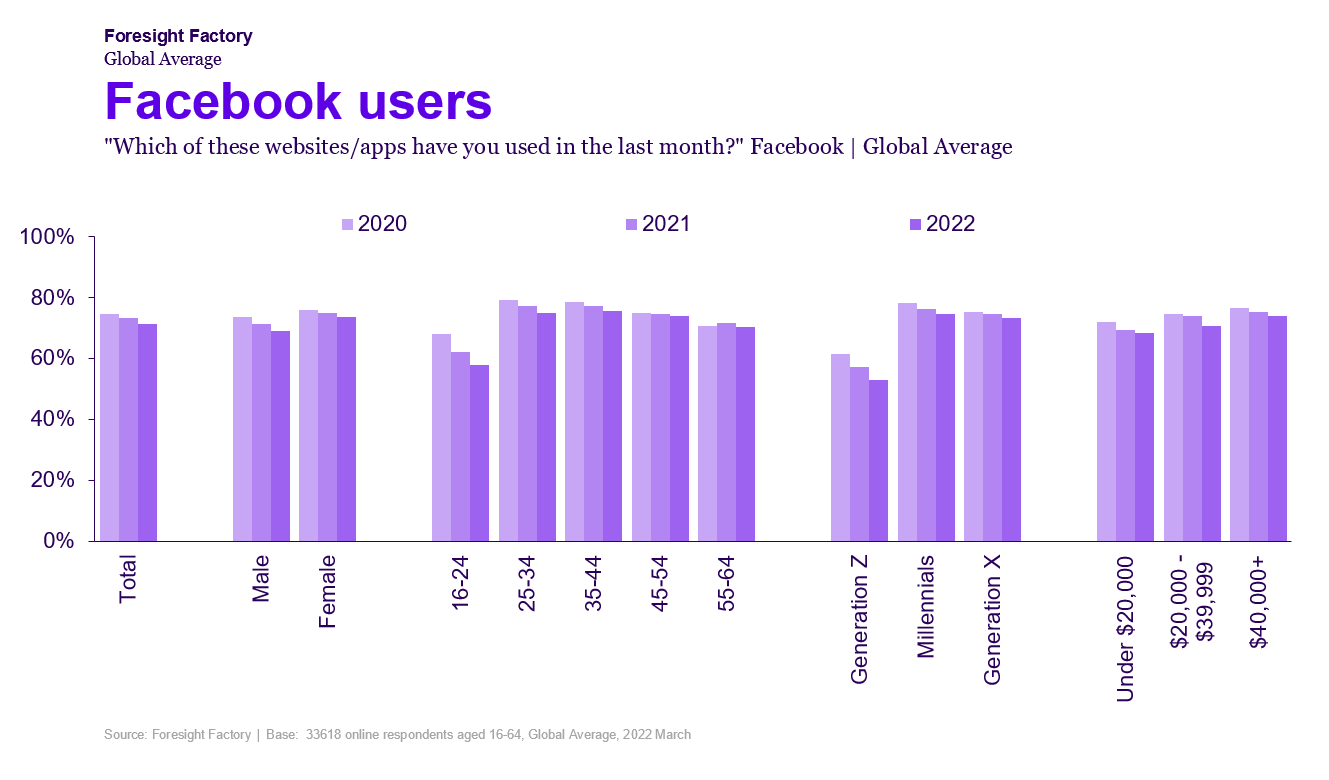As is tradition, in December we at Foresight Factory reflected on the year gone by, looking back at the cultural signals, consumer trends and events that made the biggest impact in 2022. From a contentious World Cup to unrest and upheavals among social media giants and an economy stuck in a “permacrisis”, 2022 was quite the rollercoaster. What was the real impact on consumers, and what’s in store for 2023?
Below we delve into 3 signals that came to light in December 2022, with actionable takeaways for brands.
1. Summing up the year 2022 with a word or a colour

December is typically when brands, companies and organisations around the world try to sum up the year just gone in a word, colour or meme. In 2022, Collins Dictionary was one of the first out of the blocks, selecting “permacrisis” as its word of the year. While this term particularly resonates in the UK, with its ever-changing round of prime ministers, the segue from pandemic to cost-of-living crisis to geopolitical instability has affected consumers in many parts of the globe.
A political theme also coloured Australia’s word of the year. The Australian Macquarie Dictionary chose “teal”, the colour associated with independent candidates who did well in federal elections, resulting in a so-called “teal wave”. US dictionary Merriam-Webster, on the other hand, chose the term “gaslighting” – referring to the act or practice of grossly misleading someone especially for one’s own advantage. The dictionary noted that searches for the word had increased by 1,740% over the previous year. The term is frequently associated with fractious online debates.

Cambridge Dictionary’s word of the year, “homer”, acknowledged the popularity of the mobile game Wordle, and the fact that Britain and America are still two nations divided by a common language. Oxford Languages, meanwhile, put our trend Stakeholder Customer into action by taking a public vote on its word of the year for the first time ever. Selecting from a list that included “metaverse” and “IStandWith”, voters ultimately settled on “goblin mode” – a slang term used to describe an unapologetically self-indulgent, slovenly and lazy attitude and behaviour.
While many consumers and companies spent the month of December looking back, a number of brands are looking ahead to what 2023 has in store, with colour predictions a key part of this. Paint brand Dulux has chosen “positive, glowing tone” Wild Wonder as its colour of the year for 2023, which fits nicely with our Back to Nature trend. Mylands, meanwhile, identified hot pink as its hue of the year for ’23, part of the wider Barbiecore movement. Benjamin Moore’s pick, Raspberry Blush, is also bright and unapologetically cheery, perhaps reflecting a desire for optimism and dynamism despite the expected economic doom and gloom that 2023 will bring.
See beyond
Here at Foresight Factory, we always try to stay a step ahead, which is why we revealed our key trends and themes for the coming year in our Trending 2023 report, released back in October. We foresee rebellion as the word that will define the year in many ways – as already seen in strikes and protests around the world, most recently in China as well as the rail and NHS strikes in the UK. Download the report preview to understand how a rebellious mindset will impact consumer behaviour in 2023, or read our blog posts on retail and travel in 2023 for more sector-focused insights.
We will also be offering a more detailed preview of 2023 in our next webinar, coming to a screen near you on 19 January. During this session we highlighted some of the key dates and events to look out for in the year ahead, putting them in the context of wider consumer changes, with sector-specific recommendations for action across the year. Watch the webinar here.
2. Worlds and views collided in Qatar

Normally, there’s a buzz of excitement around the World Cup that’s essentially inescapable, even for non-football fans. But this year, numerous controversies leading up to the event somewhat dulled the sheen of the beautiful game. First, the controversial bid from Qatar, and later the uncovering of widespread corruption and bad practice within FIFA’s executive committee at the time. Then came the human rights violations against the working migrants building the stadium, as well as backlash against FIFA’s claim that this World Cup would be carbon neutral.
Even after the first match kicked off on 20 November, the controversies kept rolling in. FIFA became the middleman between the conservative views of the Qatari nation and the largely liberal views of many Western countries taking part, leading to a massive culture clash. We saw last minute U-turns on alcohol sales and the rules around wearing rainbow colours, creating uncertainty for brands associated with the competition, most notably Budweiser. And notable figures turned to protesting Qatar’s position on inclusivity issues, either subtly or overtly taking steps to show their solidarity with the LGBTQ+ community.
But despite all of this, millions of people across the world still tuned in. Thousands reacted to the shock losses from Argentina and Germany and the wins from France and England, while the USA–England match drew a record US viewership for men’s soccer. Evidently, many consumers were able to focus on the tournament itself after all.
One reason for this could be that the competition came at a time when people desperately needed a distraction. Going into 2023, the doom and gloom of a likely global recession was on the horizon. Meanwhile, the cost-of-living crisis continued as consumers geared up for holidays such as Christmas, putting them under immense pressure to cut back on any extraneous costs while also trying to maintain their quality of life and find reasons to celebrate. In this context, the World Cup presented a rare opportunity to band together and celebrate, without it costing a thing.
See beyond
Football attracts fans from all walks of life, making it a powerful unifier. And yet, when host countries put limitations on who is allowed to participate (in sport or in daily life), we inevitably see clashes and polarisation. Defining your brand’s positioning when these tensions occur is one of the key elements outlined in our trend Everyday Activism, which underscores what role brands can and should take when it comes to protest and conscious consumption.
The World Cup presents a key opportunity for brands to talk to Sports Fans, a global tribe of consumers who are particularly passionate about sports and who regard their affiliation with certain teams and sports stars as a central and dominant feature of their personal identities. Our Sports Fans Tribe report is packed data-backed insights into how to resonate with this cohort.
As the new year begins, bringing with it fears and concerns about finances and uncertainty, consumers are hungry for reasons to celebrate. Collision members can explore our trend Everyday Celebration to understand how brands are invited to act as intermediaries for celebration-seeking consumers.
3. What to expect for social media in 2023

Twitter appears to be in turmoil since Elon Musk’s takeover. There have been widespread employee dismissals, and brands like Apple are reducing their ad spend on the platform. Smaller networks, some new and some long established, are benefitting from the chaos. The decentralised platform Mastodon reportedly saw its downloads rise 657% after Musk took ownership of Twitter, and microblogging platform Tumblr saw a 77% increase in downloads. This is compared to a 21% rise in downloads of Twitter (source: SensorTower).
But Twitter isn’t the only major platform hitting roadblocks. Use of Facebook is generally in decline (see chart below), particularly among the young, while Meta has laid off around 13% of its workforce, and the company’s market value has plunged.

Despite this, it may not yet be the time for brands to jump ship from Twitter and other big platforms. Emerging networks like Mastodon (which has recently hit 1 million downloads) or CounterSocial have not yet proven their longevity. And for a brand to establish a presence on a new platform means adopting new approaches to messaging, advertising and content creation – multiple potential risks.
Consider monitoring which smaller platforms your audience is turning to, seeing how early adopters use them and waiting for real evidence that a move would bring value to your brand. That being said, if you have the resources to experiment, explore a trial-and-error approach, closely watching what works and what doesn’t.
See beyond
We predicted the fragmentation of social media use in our report Niche Networks. Consumers will be spending more time with like-minded peers and strangers on smaller platforms, while bigger social sites become spaces for personal brand-building. Brands should prepare for this fragmented future, where consumers’ attention is divided across multiple platforms and once-dominant players like Twitter and Facebook hold less sway.
Meet Collision, the trends platform that can make a real difference to your business
These signals first appeared as part of our What’s trending in December 2022? report, published on Collision, our dynamic trends intelligence platform. Members get access to these reports at the beginning of every month, so they always have a finger on the pulse of consumers and culture. If you’re interested in learning more about Collision and how the platform can make a difference to your business, get in touch today.